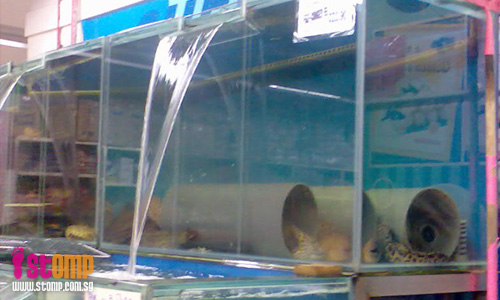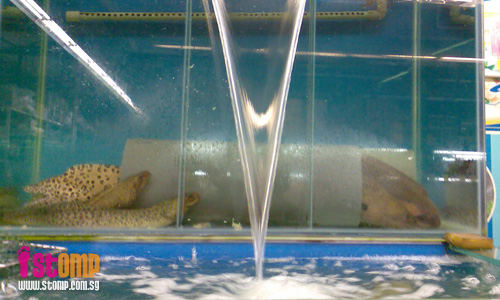
STOMPer John was appalled that these pike conger eels were on sale at a local supermarket.
In an email to STOMP today, the STOMPer says:
"I was shocked to see live pike conger eels on sale for $23.90/KG at a local supermarket.
"These eels are such a beauty, and yet people are slaughtering and eating them.
"Nothing better to eat?"


I don't think these are pike conger eels (F. Muraenesocidae). Instead, I strongly believe that the eels in the photos are actually moray eels (F. Muraenidae), although I am unable to narrow it down further to the species.
The beauty of an animal in no way affects its edibility. There is nothing fundamentally wrong with eating moray eels, although I am a little concerned about whether moray eels are capable of supporting any sort of commercial fishery. Another point to consider is that the moray eels in the photos above are all probably juveniles. If a commercial fishery develops around harvesting juvenile moray eels, I'm not sure how long it would take before the population collapses. Moray eels are caught for consumption in many parts of the world, but several of the larger species are thought to breed slowly, and hence would be highly vulnerable to overexploitation.
Having said that, various species of moray eels are quite popular in the aquarium trade. I wonder if any aquarists would be horrified to discover that a possibly valuable and expensive moray eel was being sold for food.
I cannot seem to find any information about moray eels being bred in captivity. What is known about their reproductive habits indicates that moray eels release their eggs and sperm into the water. Like many other marine fish, moray eel larvae are pelagic, spending some time drifting with the plankton. Subsequently, they grow into transparent larvae known as leptocephali, a stage they share in common with other eel families, before finally maturing into miniature versions of their parents and settling down in a suitable area. Hence any moray eel seen in captivity, whether destined for the aquarium or for the dining table, was collected from the wild. Rick Macpherson, who writes the excellent blog Malaria, Bedbugs, Sea Lice, & Sunsets, has an excellent post about moray eel reproduction.
After a bit of reading up on moray eels and other closely related eel families, it would seem that eels in general are highly popular as food, even though most species are highly vulnerable to overfishing. So while the beauty (or lack thereof) of a moray eel is not a factor that determines whether it should or should not be eaten, the sustainability of such an act should always be taken into account. It's not as if moray eels are a staple part of a Singaporean's diet. I guess these moray eels are being sold more for the novelty effect that comes with consuming an exotic creature few other Singaporeans have sampled before.